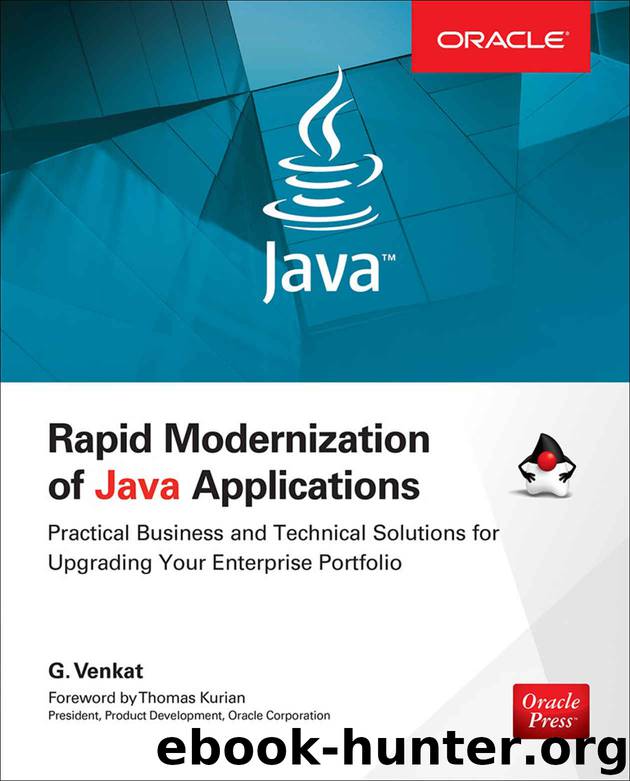Rapid Modernization of Java Applications: Practical Business and Technical Solutions for Upgrading Your Enterprise Portfolio (Oracle Press) by G. Venkat

Author:G. Venkat [Venkat, G.]
Language: eng
Format: azw3
Publisher: McGraw-Hill Education
Published: 2017-10-06T04:00:00+00:00
The Solution Stack for Java Portfolio Assessment
Earlier in this chapter, we discussed the conceptual architecture and enablement of the solution stack for Java application assessments. Several tools are available to support these assessments, many of which have been created using open-source software. Because there is no single comprehensive tool that can address the needs of an entire solution stack, the best approach would be to mix and match the best-of-breed tools to assemble the solution stack. Before many of these tools became available, I built a solution stack from the ground up. However, with technological advancements over the years, it is not necessary to custom tool the entire stack. In fact, it is more economical and efficient to use existing resources first.
Although this section will also touch upon some of the proprietary tools available today, it is important to note that none of them provides a complete solution and, in many respects, none provides feature sets as complete as some open-source options. Regardless of the selected toolset, a significant time and budgetary investment is necessary to train available resources and familiarize the teams with the adopted solution stack. Additionally, enterprises must also account for the inevitable implementation of supplementary supporting tools to fill in the gaps and achieve complete solution stack automation.
The ideal solution stack will consist of tools that can do the following:
Automatically discover all the assets contained in a Java application portfolio.
Provide interfaces to add, delete, and update application related attributes manually and programmatically.
Score various attributes and generate comparison graphs.
Enable creation of rules that can be applied to the migration automation.
Apply in-built and custom rules to analyze the portfolio.
Recommend modernization and migration options.
Automatically replace existing code with suggested options.
Verify and validate modernized or migrated code with full test automation.
The sections that follow delve deeper into the available tools and present the features and capabilities of these tools so that enterprises can make their own determination as to what tools they should adopt and further customize.
Download
This site does not store any files on its server. We only index and link to content provided by other sites. Please contact the content providers to delete copyright contents if any and email us, we'll remove relevant links or contents immediately.
The Mikado Method by Ola Ellnestam Daniel Brolund(20603)
Hello! Python by Anthony Briggs(19899)
Secrets of the JavaScript Ninja by John Resig Bear Bibeault(18208)
The Well-Grounded Java Developer by Benjamin J. Evans Martijn Verburg(17575)
OCA Java SE 8 Programmer I Certification Guide by Mala Gupta(17421)
Kotlin in Action by Dmitry Jemerov(17183)
Algorithms of the Intelligent Web by Haralambos Marmanis;Dmitry Babenko(16234)
Grails in Action by Glen Smith Peter Ledbrook(15390)
Sass and Compass in Action by Wynn Netherland Nathan Weizenbaum Chris Eppstein Brandon Mathis(13265)
Test-Driven iOS Development with Swift 4 by Dominik Hauser(10393)
Windows APT Warfare by Sheng-Hao Ma(7833)
Layered Design for Ruby on Rails Applications by Vladimir Dementyev(7548)
Blueprints Visual Scripting for Unreal Engine 5 - Third Edition by Marcos Romero & Brenden Sewell(7448)
Solidity Programming Essentials by Ritesh Modi(4565)
Functional Programming in JavaScript by Mantyla Dan(4436)
Hands-On Full-Stack Web Development with GraphQL and React by Sebastian Grebe(4429)
WordPress Plugin Development Cookbook by Yannick Lefebvre(4382)
Unity 3D Game Development by Anthony Davis & Travis Baptiste & Russell Craig & Ryan Stunkel(4269)
The Ultimate iOS Interview Playbook by Avi Tsadok(4252)
